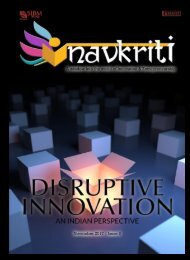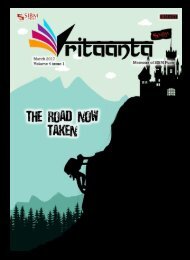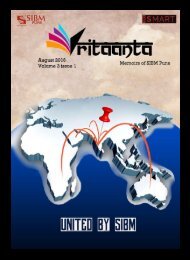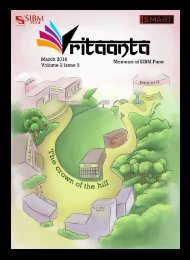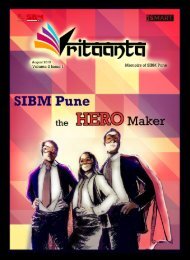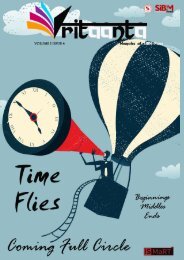Vritaanta Volume 3 Issue 2 November 2016
This issue focuses on the factor that makes SIBM Pune stand out from the crowd--the student-driven culture that is one of the core values of the 39-year-old heritage of the institution. Also, this issue covers the stories of the participants and winners of competitions like Godrej LOUD, ITC Interrobang, Mahindra War Room etc.
This issue focuses on the factor that makes SIBM Pune stand out from the crowd--the student-driven culture that is one of the core values of the 39-year-old heritage of the institution. Also, this issue covers the stories of the participants and winners of competitions like Godrej LOUD, ITC Interrobang, Mahindra War Room etc.
Create successful ePaper yourself
Turn your PDF publications into a flip-book with our unique Google optimized e-Paper software.
22<br />
Pedagogy<br />
Key technological trends are driving evolution of CRM<br />
into next generation Social CRM systems:<br />
Cloud Computing/SaaS CRM<br />
Social Media channels (like Twitter and Facebook) generate<br />
tremendous volume of user generated content created<br />
by millions of users. It is not possible for CRM system to<br />
import/ store the data “locally”. SaaS Model makes it possible<br />
to store information in the “cloud” (shared space)<br />
and access it from (Social) CRM application “on-demand”<br />
Social Media space is changing and evolving rapidly. Very<br />
difficult, if not impossible, for any CRM vendor to incorporate<br />
all new channels and feeds “locally” for every installation<br />
of CRM system.<br />
Service Oriented Architecture (SOA)<br />
lyze past-customer behaviour, but predict future behaviour<br />
too based on statistical models. Predictive analytics<br />
logic/ modules can be “embedded” in Social CRM work<br />
flows to analyze and predict customer behavioral from<br />
“real-time” social network data feed and take corrective<br />
action by triggering appropriate work-flows based on<br />
pre-defined business rules.<br />
Smart Phones and Tablet PCs<br />
Mobile phones have evolved from “simple” telephones<br />
to mobile multi-media communication hub connected<br />
to the Internet via “always on” wireless broadband connection.<br />
It is estimated that currently more than 650 million<br />
people worldwide, or 13.4% of mobile subscribers<br />
use the Web via a mobile device at least once a month.<br />
This number is all set to skyrocket as inexpensive smart<br />
phones continue to flood the market. Similarly, Tablet<br />
PCs, given their large hi-resolution screen with multitouch<br />
input, accelerometer sensor for UI, touchsensitive<br />
controls and high speed internet access via<br />
3G/4G or Wifi/WiMax have the potential to change the<br />
way we use social media tools and take social networking<br />
to a whole new level.<br />
Enterprise application and data mashups<br />
Service Oriented Architecture and Cloud Computing not<br />
only make it easy to integrate applications, but also facilitate<br />
“plug and play” modules and add-ons that can dramatically<br />
reduce time and cost involved in extending functionality<br />
of the application. SOA design is of great help in<br />
Social CRM as new social media tools and functionality<br />
can be added without expensive customization or upgrades<br />
as was the case in traditional CRM systems.<br />
Real Time “In Process” Analytics<br />
Predictive analytics has made it possible not only to ana-<br />
In any large or medium enterprise, we have a diverse<br />
range of applications such as “on premise” CRM or SaaS<br />
CRM, BPM, MDM, ERP, etc. to name just a few. Adding<br />
social networks to enterprise application landscape increases<br />
complexity of integrating and managing all the<br />
applications exponentially not only because of amount<br />
of data generated by users on social networks but also<br />
the need to monitor and respond in “real time”. In a Social<br />
CRM system for example, Enterprise Application<br />
and Data Mashups can be used to combine data/<br />
functionality from multiple applications such as CRM,<br />
MDM, ERP, etc. and new services can be created “onthe-fly”<br />
or specific workflows can be triggered based on<br />
pre-defined business rules in a user friendly way.<br />
With Social CRM, the communication has become more<br />
interactive and also the frequency of reaching out to the<br />
customers has increased drastically. Used in an effective<br />
manner Social CRM can help build better customer relationship<br />
and increase customer loyalty.<br />
VRITAANTA <strong>November</strong> <strong>2016</strong>





